Entry to Cambodia is normally refused if you have a passport with less than six months’ validity, or which is damaged or has pages missing. Neighbouring counties have different validity requirements and travellers should check those separately.
Thing to do in Siem Reap
Angkor Wat
 This is without a doubt a must see since its one of the Seven Wonders of the World. Angkor consists of a large group of magnificent temples, approximately 100 in all, which were built from 879–1191AD by the Khmer civilisation. From Angkor the Khmer ruled a vast empire, which stretched from present day Vietnam to Yunan in China. These temples are one of the only surviving remains of this powerful empire. Angkor Wat is the largest temple in the Angkor complex. This temple was built by Suryavaram II in order to honour the Hindu God Vishnu, with whom the king was identified and this was also to be his burial spot. A visit to Angkor Wat is a must, even if just to see the architectural mastery involved.
This is without a doubt a must see since its one of the Seven Wonders of the World. Angkor consists of a large group of magnificent temples, approximately 100 in all, which were built from 879–1191AD by the Khmer civilisation. From Angkor the Khmer ruled a vast empire, which stretched from present day Vietnam to Yunan in China. These temples are one of the only surviving remains of this powerful empire. Angkor Wat is the largest temple in the Angkor complex. This temple was built by Suryavaram II in order to honour the Hindu God Vishnu, with whom the king was identified and this was also to be his burial spot. A visit to Angkor Wat is a must, even if just to see the architectural mastery involved.
The Bayon
 Fifteen hundred metres of straight road separate the south gate of Angkor Thom from the Bayon. Built in the late 12th century or early 13th century as the official state temple of the Mahayana Buddhist King Jayavarman VII, the Bayon stands at the centre of Jayavarman's capital, Angkor Thom. Following Jayavarman's death, it was modified and augmented by later Hindu and Theravada Buddhist kings in accordance with their own religious preferences.
Fifteen hundred metres of straight road separate the south gate of Angkor Thom from the Bayon. Built in the late 12th century or early 13th century as the official state temple of the Mahayana Buddhist King Jayavarman VII, the Bayon stands at the centre of Jayavarman's capital, Angkor Thom. Following Jayavarman's death, it was modified and augmented by later Hindu and Theravada Buddhist kings in accordance with their own religious preferences.
We recommend that, skirting it to the right, you gain access to the temple by the long redented eastern terrace, embellished with lions and naga-balustrades, that corresponds to its main
entrance. One can see that the naga motif here is representative of the last period, where the hood is straddled by a garuda. On either side are the remains of ancient pools.
The Bayon best presents itself in the morning, when the sunlight is the most favourable. One should not fail, however, to return by the light of the moon, when the lines and shadows become softened and the stone and its verdant background composed in a perfect unity of hue and tone - when the faces, mellow and subdued, take on an emotive expression from which radiates a sort of lyrical charm - where each becomes exaggerated in over-scale, doubled in profile and infinitely multiplied. One dissolves in the serenity of this Buddhist tranquillity, embryonic amongst the phantoms.
Baphuon
 Baphuon he Baphuon adjoins the southern enclosure of the Royal Palace. Built in the mid-11th century, it is a three-tiered temple mountain built as the state temple of Udayadityavarman II dedicated to the Hindu God Shiva. It is the archetype of the Baphuon style.
Baphuon he Baphuon adjoins the southern enclosure of the Royal Palace. Built in the mid-11th century, it is a three-tiered temple mountain built as the state temple of Udayadityavarman II dedicated to the Hindu God Shiva. It is the archetype of the Baphuon style.
15 Its outer eastern gopura lies on the same longitudinal axis as the Elephant Terrace, which also aligns with the central tower
of the Bayon, located just to the south. The two temples differ in age and are not, however, related, but rather juxtaposed in an apparently aimless manner that suggests no ancient connection. On its three other sides the temple is surrounded by a moulded enclosure wall, constructed unusually in sandstone which, to the north, becomes a retaining wall since the embankment has been filled. The dimensions of this rectangle are 425 metres by 125. Measuring 120 metres east-west by 100 metres north-south at its base, the temple-mountain of the
Baphuon stands between the royal palace enclosure and the earth embankment which, bordering to the south, probably constituted the north bank of the moat surrounding the capital of Yasovarman, centred on
Phnom Bakheng during the ninth century. Its considerable size would make it without doubt one of the more imposing of the Angkor monuments - were it located on a less restricted site. This is “the Copper Tower higher even than the Golden Tower (the Bayon) - a truly astonishing spectacle” described by Tcheou Ta- Kouan at the end of the 13th century.
Ta prohm
 Ta Prohm is the modern name of a temple at Angkor, Siem Reap Province, Cambodia, built in the Bayon style largely in the late 12th and early 13th centuries and originally called Rajavihara (in Khmer). Located approximately one kilometre east of Angkor Thom and on the southern edge of the East Baray, it was founded by the Khmer King Jayavarman VII as a Mahayana Buddhist monastery and university. Unlike most Angkorian temples, Ta Prohm has been left in much the same condition in which it was found: the photogenic and atmospheric combination of trees growing out of the ruins and the jungle surroundings have made it one of Angkor's most popular temples with visitors.
Ta Prohm is the modern name of a temple at Angkor, Siem Reap Province, Cambodia, built in the Bayon style largely in the late 12th and early 13th centuries and originally called Rajavihara (in Khmer). Located approximately one kilometre east of Angkor Thom and on the southern edge of the East Baray, it was founded by the Khmer King Jayavarman VII as a Mahayana Buddhist monastery and university. Unlike most Angkorian temples, Ta Prohm has been left in much the same condition in which it was found: the photogenic and atmospheric combination of trees growing out of the ruins and the jungle surroundings have made it one of Angkor's most popular temples with visitors.
Ta Prohm should be visited either in the afternoon or the early morning, and crossed from west to
east according to the itinerary that we have traced on the plan. This precaution will prevent the visitor with
limited time from becoming disorientated, due to the relative simplicity of a clearly marked route. In contrast, those who wish to spend several hours exploring the monument will find here the potential for an adventure - but without danger of ever getting lost, since the main axis is clearly defined from place to place by an uninterrupted line of rooms and vestibules, almost always made inaccessible by their collapse but providing neverthelessa good point of reference. We would advise, however, not to wander but with extreme caution in the areas of crumbling vaulted galleries remote from the normally frequented passageways.
Banteay Kdei
 Banteay Kdei (Khmer:Prasat Banteay Kdei) is a temple at Angkor, Cambodia. It is located southeast of Ta Prohm and east of Angkor Thom. Built in the late 12th to early 13th centuriesCE during the reign of Jayavarman VII, it is a Buddhist temple in the Bayon style, similar in plan to Ta Prohm and Preah Khan, but less complex and smaller. Its structures are contained within two successive enclosure walls, and consist of two concentric galleries from which emerge towers, preceded to the east by a cloister.
Banteay Kdei (Khmer:Prasat Banteay Kdei) is a temple at Angkor, Cambodia. It is located southeast of Ta Prohm and east of Angkor Thom. Built in the late 12th to early 13th centuriesCE during the reign of Jayavarman VII, it is a Buddhist temple in the Bayon style, similar in plan to Ta Prohm and Preah Khan, but less complex and smaller. Its structures are contained within two successive enclosure walls, and consist of two concentric galleries from which emerge towers, preceded to the east by a cloister.
This monastic complex is currently dilapidated due to faulty construction and poor quality sandstone. Banteay Kdei has been occupied by monks at various intervals over the centuries, but the inscription stone has never been discovered so it is unknown to whom the temple is dedicated.
Srah Srang “The royal bathing pool”
 It was digged in the mid-10th century, by initiative of Kavindrarimathana, buddhist minister of Rajendravarman II. Then it was modified about year 1200 by Jayavarman VII, who added the laterite landing-stage at its western side too, likely because the East Baray had been overwhelming by sediment and begun malfunctioning. French archeological expeditions have found a necropolis close to it.
It was digged in the mid-10th century, by initiative of Kavindrarimathana, buddhist minister of Rajendravarman II. Then it was modified about year 1200 by Jayavarman VII, who added the laterite landing-stage at its western side too, likely because the East Baray had been overwhelming by sediment and begun malfunctioning. French archeological expeditions have found a necropolis close to it.
Leaving Banteay Kdei by the east gate and crossing the road near the 11 kilometre marker stone one gains, in a few paces, an elegant embarkation terrace, axial on the temple and dominating the area of water known as the Srah Srang. This measures 700 metres by just over 300 and, slightly off axis, was without doubt excavated before the reign of Jayavarman VII. It has a border of laterite steps with an outer margin of sandstone. Its centre is marked by a small island on which some jointed stone blocks perhaps formed the base for a small light-weight pavilion. Entirely surrounded by large trees and always full of water it provides, in the fading light of day, one of the most delightful settings in the Angkor Park - its majestic calm particularly recalling certain views in Versailles, such as the Pièce d’eau des Suisses or the Grand Canal. The terrace, with a moulded sandstone base on laterite foundations, must have supported some light-weight construction which, to judge by the plan of doubled small courtyards, consisted of a large rectangular room with surrounding galleries. An axial stairway flanked by two lions divides into three branches with an intermediate landing - a pleasing arrangement which has allowed the naga-balustrades to be set out in a particularly decorative manner. The rich ornamentation remains refined in style despite the profusion of its elements. To the fore, an enormous garuda rides a three headed naga while the other heads serve to frame it, - to the rear, again the three headed naga with the thighs of the garuda clearly indicated and its stylised tail ornate with small naga heads. The body of the naga rests on blocks sculpted with monsters standing “as atlantes”. This is undoubtedly the triumph of a formula which, although perhaps questionable, is nonetheless characteristic of the Bayon style.
Banteay Srei
 Banteay Srei (or Banteay Srey) (Khmer) is a 10th century Cambodian temple dedicated to the Hindu god Shiva.
Banteay Srei (or Banteay Srey) (Khmer) is a 10th century Cambodian temple dedicated to the Hindu god Shiva.
The miniature temple of Banteay Srei is located twenty kilometres north-east of the Bayon as the crow flies, not far from the right bank of the Stung Siem Reap, the river that descends from the Phnom Kulen to flow into the Tonle Sap. Situated in the middle of the forest, small in scale and in a region lacking in archaeological remains, one can understand why it escaped general attention for so long - its discovery by lieutenant Marec, an officer in the geographic service, was in fact only made in 1914. It was not cleared until 1924, following the theft and ensuing scandal the previous year of some important stones. These were eventually recovered and restored to their original positions during the course of
restoration work. The total success of the anastylosis, undertaken by Mr Marchal, caused the general adoption of this technique for the restoration of the monuments by our archaeological service, directly inspired by methods used by archaeologists in Java - and although the task at Banteay Srei was eased by the diminutive volume of the buildings, by the small blocks of stone cut from a durable sandstone which retained its sharp profiles and by the abundance of a remarkably well preserved and clearly visible decoration, the achievement of Mr Marchal is no less impressive since he was obliged to employ his skill on a particularly distant site with difficult access and with minimal means - and with an unskilled and inexperienced work force who had first to be trained from scratch.
The track to Banteay Srei, though sandy in places, is always passable by car, except for three or four weeks from September to October when the rains are particularly heavy. It leaves the Grand Circuit between Pre Rup and the eastern Mebon to head east through the delightful village of Pradak, where it forks to the north, at two kilometres from the point of its departure, to skirt, after another ten kilometres, the village of
Khna - where those with a taste for coconut milk will be able to refresh themselves on their return. After six more kilometres it leads to a parking area. Walking from the river, which here cuts deep and is cleared by a foot bridge, one finally gains, by the road straight ahead and at the first fork, the eastern entrance to the temple - after some 500 metres. 33 monuments beyond the circuits.
Not the temples
Tonle Sap Lake
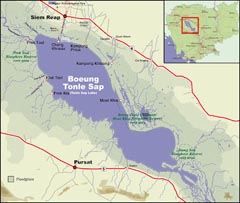 Cambodia's Great Lake, the Boeung Tonle Sap (Tonle Sap Lake,) is the most prominent feature on the map of Cambodia - a huge dumbbell-shaped body of water stretching across the northwest section of the country. In the wet season, the Tonle Sap Lake is one of the largest freshwater lakes in Asia, swelling to an expansive 12,000 km2. During the dry half of the year the Lake shrinks to as small as 2500 km2, draining into the Tonle Sap River, which meanders southeast, eventually merging with the Mekong River at the 'chaktomuk' confluence of rivers opposite Phnom Penh. But during the wet season a unique hydrologic phenomenon causes the river to reverse direction, filling the lake instead of draining it. The engine of this phenomenon is the Mekong River, which becomes bloated with snow melt and runoff from the monsoon rains in the wet season. The swollen Mekong backs up into the Tonle Sap River at the point where the rivers meet at the 'chaktomuk' confluence, forcing the waters of the Tonle Sap River back upriver into the lake. The inflow expands the surface area of lake more than five-fold, inundating the surrounding forested floodplain and supporting an extraordinarily rich and diverse eco-system. More than 100 varieties of waterbirds including several threatened and endangered species, over 200 species of fish, as well as crocodiles, turtles, macaques, otter and other wildlife inhabit the inundated mangrove forests. The Lake is also an important commercial resource, providing more than half of the fish consumed in Cambodia. In harmony with the specialized ecosystems, the human occupations at the edges of the lake is similarly distinctive - floating villages, towering stilted houses, huge fish traps, and an economy and way of life deeply intertwined with the lake, the fish, the wildlife and the cycles of rising and falling waters.
Cambodia's Great Lake, the Boeung Tonle Sap (Tonle Sap Lake,) is the most prominent feature on the map of Cambodia - a huge dumbbell-shaped body of water stretching across the northwest section of the country. In the wet season, the Tonle Sap Lake is one of the largest freshwater lakes in Asia, swelling to an expansive 12,000 km2. During the dry half of the year the Lake shrinks to as small as 2500 km2, draining into the Tonle Sap River, which meanders southeast, eventually merging with the Mekong River at the 'chaktomuk' confluence of rivers opposite Phnom Penh. But during the wet season a unique hydrologic phenomenon causes the river to reverse direction, filling the lake instead of draining it. The engine of this phenomenon is the Mekong River, which becomes bloated with snow melt and runoff from the monsoon rains in the wet season. The swollen Mekong backs up into the Tonle Sap River at the point where the rivers meet at the 'chaktomuk' confluence, forcing the waters of the Tonle Sap River back upriver into the lake. The inflow expands the surface area of lake more than five-fold, inundating the surrounding forested floodplain and supporting an extraordinarily rich and diverse eco-system. More than 100 varieties of waterbirds including several threatened and endangered species, over 200 species of fish, as well as crocodiles, turtles, macaques, otter and other wildlife inhabit the inundated mangrove forests. The Lake is also an important commercial resource, providing more than half of the fish consumed in Cambodia. In harmony with the specialized ecosystems, the human occupations at the edges of the lake is similarly distinctive - floating villages, towering stilted houses, huge fish traps, and an economy and way of life deeply intertwined with the lake, the fish, the wildlife and the cycles of rising and falling waters.
The lake sits only about 15 km south of Siem Reap town. If you take the ferry between Phnom Penh and Siem Reap you will cross the lake and dock at the village of Chong Khneas. There are several ways to see the culture and wildlife of the lake area depending on the amount of time you have and your interest.
Chong Khneas
 Chong Khneas is the floating village at the edge of the lake closest and most accessible to Siem Reap. If you want a relatively quick and easy look at the Tonle Sap, boat tours of Chong Khneas are available, departing from the Chong Khneas boat docks all day long. Take a motodup or taxi the 11-15km from Siem Reap to the boat docks where there are always boats waiting for passengers. A two-hour boat trip through the floating village runs $6 and the boats may carry as many as 15 other people. The boatman will probably point out the differing Khmer and Vietnamese floating households and the floating markets, clinics, schools and other boatloads of tourists. Chong Khneas, while interesting, is over-touristed and is not as picturesque and 'unspoiled' as floating villages further from Siem Reap. The boat trip usually includes two stops: one at a touristy floating 'fish and bird exhibition' with a souvenir and snack shop, and the other at the very highly recommended Gecko Environment Centre, which offers displays and information introducing the ecology and biodiversity of the lake area.
Chong Khneas is the floating village at the edge of the lake closest and most accessible to Siem Reap. If you want a relatively quick and easy look at the Tonle Sap, boat tours of Chong Khneas are available, departing from the Chong Khneas boat docks all day long. Take a motodup or taxi the 11-15km from Siem Reap to the boat docks where there are always boats waiting for passengers. A two-hour boat trip through the floating village runs $6 and the boats may carry as many as 15 other people. The boatman will probably point out the differing Khmer and Vietnamese floating households and the floating markets, clinics, schools and other boatloads of tourists. Chong Khneas, while interesting, is over-touristed and is not as picturesque and 'unspoiled' as floating villages further from Siem Reap. The boat trip usually includes two stops: one at a touristy floating 'fish and bird exhibition' with a souvenir and snack shop, and the other at the very highly recommended Gecko Environment Centre, which offers displays and information introducing the ecology and biodiversity of the lake area.
Prek Toal Bird Sanctuary
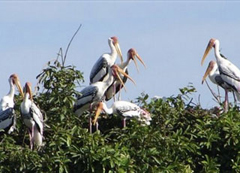 The 'bird sanctuary' at the Prek Toal core area of the Tonle Sap Biosphere Reserve has been called "the single most important breeding ground in Southeast Asia for globally threatened large waterbirds." The Biosphere covers 31,282 hectares at the northwest tip of the Tonle Sap Lake and plays host to species including Greater and Lesser Adjuncts, Black-headed Ibis, Painted Stork, Milky Stork, Spot-billed Pelican, Grey-Headed Fish Eagle and many more species. Of the three Biosphere core areas on the Tonle Sap Lake, Prek Toal is the most accessible from Siem Reap and the most popular with birdwatchers. The best time of year for viewing is the dry season when flocks of migratory birds congregate at Prek Toal. As the dry season progresses and the water recedes, the number of birds increases but the travel to some of the more important viewing areas becomes more difficult.
The 'bird sanctuary' at the Prek Toal core area of the Tonle Sap Biosphere Reserve has been called "the single most important breeding ground in Southeast Asia for globally threatened large waterbirds." The Biosphere covers 31,282 hectares at the northwest tip of the Tonle Sap Lake and plays host to species including Greater and Lesser Adjuncts, Black-headed Ibis, Painted Stork, Milky Stork, Spot-billed Pelican, Grey-Headed Fish Eagle and many more species. Of the three Biosphere core areas on the Tonle Sap Lake, Prek Toal is the most accessible from Siem Reap and the most popular with birdwatchers. The best time of year for viewing is the dry season when flocks of migratory birds congregate at Prek Toal. As the dry season progresses and the water recedes, the number of birds increases but the travel to some of the more important viewing areas becomes more difficult.
Most people arrange a trip to Prek Toal through their guesthouse or a tour operator. To do it yourself, take a moto or taxi from Siem Reap to the Phnom Krom/Chong Khneas boat dock. Arrange a boat to the Prek Toal Environmental Research Station (starting at $35-$45 return,) and then from the Research Station a $5 entrance fee and $15-$25 for a guided boat tour of the sanctuary. The Research Station has information on the area's flora and fauna. There are also basic overnight accommodations at the Research Station if you want to stay the night to take full advantage of the sunset and early morning viewing hours.
Kampong Phluk
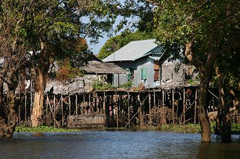 Kampong Phluk is a cluster of three villages of stilted houses built within the floodplain of the Tonle Sap about 16 km southeast of Siem Reap. The villages are primarily Khmer and have about 3000 inhabitants between them. Flooded mangrove forest surrounds the area and is home to a variety of wildlife including crab-eating macaques. During the dry season when the lake is low, the buildings in the villages seem to soar atop their 6-meter stilts exposed by the lack of water. At this time of year many of the villagers move out onto the lake and build temporary stilted houses. In the wet season when water level rises again, the villagers move back to their permanent houses on the floodplain, the stilts now hidden under the water. Kampong Phluk's economy is, as one might expect, based in fishing, primary in shrimp harvesting.
Kampong Phluk is a cluster of three villages of stilted houses built within the floodplain of the Tonle Sap about 16 km southeast of Siem Reap. The villages are primarily Khmer and have about 3000 inhabitants between them. Flooded mangrove forest surrounds the area and is home to a variety of wildlife including crab-eating macaques. During the dry season when the lake is low, the buildings in the villages seem to soar atop their 6-meter stilts exposed by the lack of water. At this time of year many of the villagers move out onto the lake and build temporary stilted houses. In the wet season when water level rises again, the villagers move back to their permanent houses on the floodplain, the stilts now hidden under the water. Kampong Phluk's economy is, as one might expect, based in fishing, primary in shrimp harvesting.
Kampong Phluk sees comparatively few foreign visitors and offers a close look at the submerged forest and lakeside village life as yet unperturbed by tourism. The area can be reached by boat from the Chong Khneas or by a combination of road and boat. Make arrangements through your guesthouse of tour operator, or charter a boat at the Chong Khneas docks (starting at $35 return for a half-day at the village). By road/boat, take a car or moto to Roluos village just off Route #6 east of Siem Reap and the take a boat through the flooded forest the rest of the way to the village. During the dry season the road is clear and you can drive all of the way to the village.
Kampong Khleang
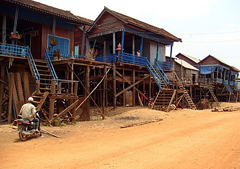 Kampong Khleang is located on the northern lake-edge about 35 km east of Siem Reap town, more remote and less touristed than Kampong Phluk. Visitors to Kampong Khleang during the dry season are universally awestruck by the forest of stilted houses rising up to 10 meters in the air. In the wet season the waters rise to within one or two meters of the buildings. Like Kampong Phluk, Kampong Khleang is a permanent community within the floodplain of the Lake, with an economy based in fishing and surrounded by flooded forest. But Kampong Khleang is significantly larger with near 10 times the population of Kampong Phluk, making it the largest community on the Lake.
Kampong Khleang is located on the northern lake-edge about 35 km east of Siem Reap town, more remote and less touristed than Kampong Phluk. Visitors to Kampong Khleang during the dry season are universally awestruck by the forest of stilted houses rising up to 10 meters in the air. In the wet season the waters rise to within one or two meters of the buildings. Like Kampong Phluk, Kampong Khleang is a permanent community within the floodplain of the Lake, with an economy based in fishing and surrounded by flooded forest. But Kampong Khleang is significantly larger with near 10 times the population of Kampong Phluk, making it the largest community on the Lake.
The area can be reached by boat from the Chong Khneas docks or by a combination of road to Domdek on Route #6 and then boat to the village, the best method depending on the time of year. During the dry season, boats cannot get all of the way to the main villages. Consult your guesthouse or tour operator about current conditions. Many tour operators have very little experience in this area so it is best to consult with adventure tour operators and guesthouses that specialize in this area. Small group tours begin at about $35 for a half day and range up through $70 depending on the size of the group and the type of tour. To get there yourself, either charter a boat from Chong Khneas or take car or moto to Domdek village on Route #6 east of Siem Reap, turn south and continue to the water's edge where boats wait to ferry passengers into the village. During the dry season the road is clear and you can take a car or moto all of the way to the village.)
Siem Reap , About Shopping Siem Reap
Siem Reap is an excellent place to buy Cambodian souvenirs, silks, handicrafts, textiles and contemporary art. Only Phnom Penh offers a comparable selection. In addition to the tradition shopping venues, over the last few of years there has been an explosion of new shops, galleries and boutiques, offering a varied selection of quality handicrafts and silks as well as original artistic creations in a variety of media.
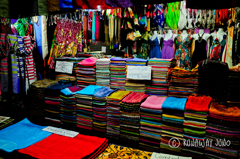
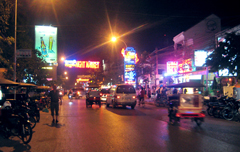 Phsar Chas (the ‘Old Market’) is one of Siem Reap’s largest traditional covered markets and offers the largest selection of souvenirs under one roof in town. In fact, this market is really a ‘must visit’ in itself for the unique, colorful, local shopping experience. Of all the local markets, the Old Market offers the widest variety of souvenirs as well as the best selection of handicrafts and curios, including such items as traditional silverwork, silks, baskets, statuary, carvings and traditional musical instruments. See the Old Market area map. Also check out the just opened Angkor Night Market off Sivatha. The new night market promises an interesting after hours shopping venue.
Phsar Chas (the ‘Old Market’) is one of Siem Reap’s largest traditional covered markets and offers the largest selection of souvenirs under one roof in town. In fact, this market is really a ‘must visit’ in itself for the unique, colorful, local shopping experience. Of all the local markets, the Old Market offers the widest variety of souvenirs as well as the best selection of handicrafts and curios, including such items as traditional silverwork, silks, baskets, statuary, carvings and traditional musical instruments. See the Old Market area map. Also check out the just opened Angkor Night Market off Sivatha. The new night market promises an interesting after hours shopping venue.
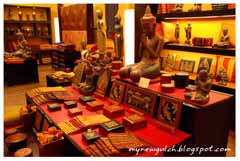
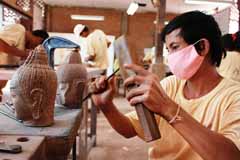 Individual little boutiques, art and photo galleries are scattered across the town, though there is a concentration of places in the Old Market area. The boutiques tend to offer higher quality, more unique and sophisticated selections of items than the Old Market - some focusing on Cambodian silks and tailoring, others on high quality handicrafts, NGO-based crafts, Asian-inspired photographic and artistic creations or specialty items such as local candles, spices and teas. Perhaps most interestingly, a new generation of Cambodian artists is making its mark and contemporary Cambodian art is coming to the fore after decades of silence. In addition to the listed galleries, check out The Arthouse Gallery at The Warehouse and the The Arts Lounge at Hotel de la Paix, both featuring regularly changing exhibits featuring the works of contemporary Cambodian artists.
Individual little boutiques, art and photo galleries are scattered across the town, though there is a concentration of places in the Old Market area. The boutiques tend to offer higher quality, more unique and sophisticated selections of items than the Old Market - some focusing on Cambodian silks and tailoring, others on high quality handicrafts, NGO-based crafts, Asian-inspired photographic and artistic creations or specialty items such as local candles, spices and teas. Perhaps most interestingly, a new generation of Cambodian artists is making its mark and contemporary Cambodian art is coming to the fore after decades of silence. In addition to the listed galleries, check out The Arthouse Gallery at The Warehouse and the The Arts Lounge at Hotel de la Paix, both featuring regularly changing exhibits featuring the works of contemporary Cambodian artists.